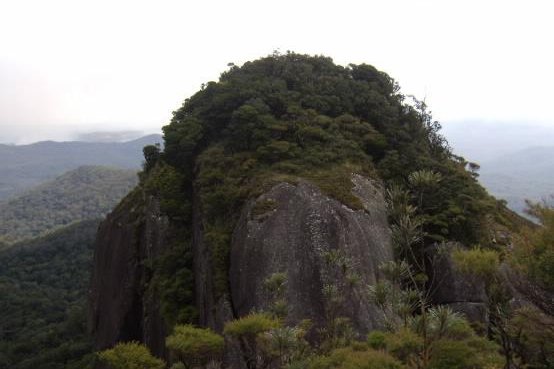1 of 2 | Kaphalim rock hosts a cloud forest in Australia's Dinden National Park. Photo by Marcia Goetze/JCU
CAIRNS, Australia, Aug. 7 (UPI) -- A new study in Australia suggests plants unique to cloud forests are unlikely to survive the changes in high-altitude temperature and weather patterns brought on by climate change.
Cloud forests are unique ecosystems typically found on the saddles of mountains in tropical regions; their position near the clouds allows plants there to strip moisture otherwise unavailable to habitats at lower elevations. Cloud forests are characterized by their mossy environs, shorter trees and peat-rich soils.
To better understand how climate change might alter these niche forests, researchers at James Cook University surveyed 19 plant species (trees and shrubs) endemic to Australia's cloud forests. Scientists then used three climate models -- ranging from conservative to extreme in their outlook -- to predict how the species will be affected by changing conditions.
The models suggest by 2040, anywhere from 17 to 100 percent of cloud forest habitat will be gone. Under the most conservative estimates, half of all cloud forest plants would be without suitable habitat by 2080.
"Our study indicates that the current climate on Queensland's mountaintops will virtually disappear," researcher Craig Costion said in a press release. "What we don't know is if these plants can adapt."
Costion is the lead author of a new paper on the predictions, published in the journal Biological Conservation.
"The 19 species represent most of the plants that are restricted to that habitat. It's highly likely they are found only there because of the climate," Costion explained. "There are plenty of other similar soil and substrate environments at lower elevations where they could grow but the climate is unsuitable."
Though cloud forests don't typically offer the same levels of biodiversity as tropical forests lower down in the valleys, they provide growing conditions and shelter for plants and animals found nowhere else.
In addition to trees and shrubs, cloud forests around the world host species of lichens, ferns, bromeliads and orchids not found in other ecosystems. Cloud forests also provide habitat to a number of endemic animals. In Peru, the unique conditions of cloud forests offer shelter and sustenance to more than a third of the nation's 270 endemic birds, mammals and frogs. The cloud forests of Central Africa are the only home to the mountain gorilla.
"The tropics contain most of the world's biodiversity, and tropical mountains are particularly rich in unique and rare species," said study co-author Darren Crayn. "Managing for global threats such as climate change requires much better information -- a redoubling of research efforts on these poorly understood landscapes would pay great dividends."
If the predictions of Crayn and Costion's models are accurate, only carefully controlled greenhouses will be able to host the species of today's cloud forests.















